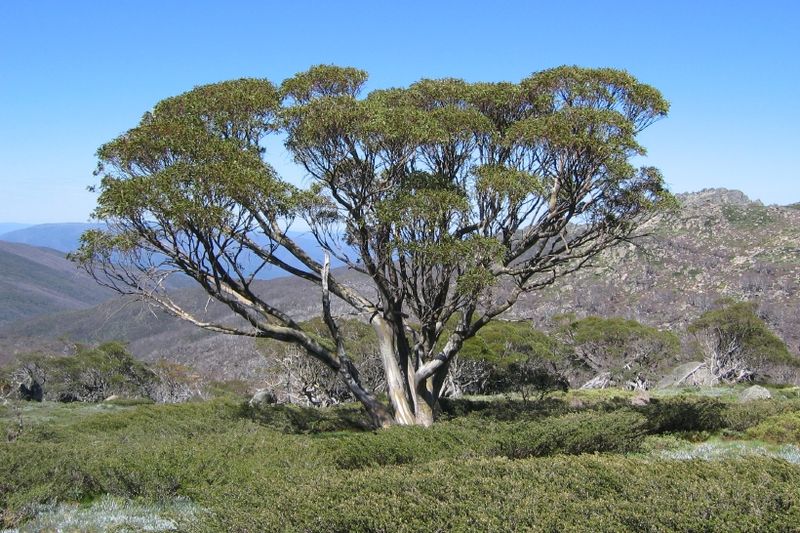Share this page:
The Snowy Mountains, located 350 km southwest of Sydney, NSW, are the highest mountain range in Australia. They contain Australia's highest mountain – Mt Kosciuszko, which has a height of 2,228 meters (7310 feet).
With snowfalls every year (in the months of June, July and August), the Snowy Mountains (or "Snowies" as they are often called) are one of the main skiing destinations in Australia. Snow is a meter deep for up to four months a year.

Snow gum in the Snowy Mountains
(Photo: Sterry2607)
A Little History
The Aborigines have lived in the Snowy Mountains area for more than 20,000 years.
Europeans first came to the area in 1835. In 1840 the explorer Count Paul Edmund Strzelecki climbed the highest mountain and named it Mount Kosciuszko after the Polish national hero General Tadeusz Kosciuszko.
During the 19th century high country stockmen let their stock graze in the pastures of the Snowy Mountains each summer. For their accommodation, the stockmen built simple mountain huts throughout the area. Many of these huts have survived and are maintained by the National Parks and Wildlife Service.
In 1859 gold was discovered near Kiandra in these mountains. This led to a small goldrush with a maximum of 15,000 people living here in 1860. Mining operations ended in Kiandra around 1908. Today Kiandra is a ghost town.
Kosciuszko National Park
A large section of the Snowy Mountains has been included in the Kosciuszko National Park. This Park contains a mixture of rugged mountains and wilderness areas, all with an alpine climate. It contains a unique mix of fauna (including the endangered Corroboree Frog and Mountain Pygmy Possum, along with a number of wild horses) and flora (mainly alpine woodlands with many snow gums and some montane and wet schlerophyll forests with alpine ash and mountain gum trees).
Skiing
With snow for up to four months a year, the Snowy Mountains now has a number of ski resorts/villages: Charlotte Pass (opened in 1930), Smiggins Holes (1939), Thredbo (early 1950s), Perisher Valley (1950s), Guthega (1950s), and Blue Cow (1980s).
In 1995, a number of these (Perisher Valley, Smiggins Holes, Guthega, and Blue Cow) merged to form Perisher Blue (since 2009 known simply as Perisher), said to be the largest ski resort in the Southern Hemisphere.
Snowy Mountains Scheme
Begun in 1949, the Snowy Mountains Scheme is perhaps Australia's most famous civil engineering scheme. The aim was to dam the Snowy River (one of the rivers in the Snowy Mountains) for purposes of irrigation (diverting water to the dry western inland areas of NSW) and of hydroelectricity.
The town of Cooma was the headquarters for the Snowy Mountains Scheme. Several other towns -- such as Adaminaby, Jindabyne and Talbingo -- were submerged by rising waters of new lakes formed by the construction of the Scheme's new dams.
The scheme employed more than 100,000 workers with the majority of them coming from over thirty overseas countries. This was an important event in the turning of Australia into the multicultural country that it is today.
An unintended consequence of the Snowy River Scheme's diversion of water from the Snowy River has been that lower reaches of the Snowy River have been thrown into environmental crisis and their ecosystem seriously damaged. The Snowy Water Inquiry, set up in 1988, recommended an increase to 15% of natural flows being allowed down the Snowy River.
Share this page:
Author: David Paul Wagner
(David Paul Wagner on Google+)
|